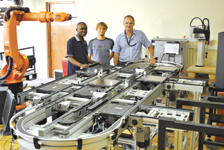

Tectra Automation has joined forces with the Mechatronics, Automation and Design Research Group (MADRG) of Stellenbosch University’s Department of Mechanical and Mechatronic Engineering to help conduct research into reconfigurable assembly systems (RAS). Under the supervision of Professor Anton Basson, the MADRG has established a laboratory-scale RAS to develop the expertise required to implement such a system in the South African market.
“The distinguishing feature of RAS is that they are aimed at the flexibility required to produce a wide variety of products, in contrast to the more conventional approach, where an assembly system is designed to produce a large volume of nearly identical items,” explains Basson.
Most of South Africa’s manufacturing exports are aimed at niche markets, implying that relatively small volumes of high variety products are produced. Manual assembly is readily adaptable to product variety, but the quality requirements for exported goods are often difficult to meet using manual labour alone. In order to meet these demands, a good combination of manual and automated production is required from local manufacturing operations.
A key component of the Stellenbosch laboratory RAS is the Bosch Rexroth TS2-Plus pallet-based conveyor system provided by Tectra Automation. This conveyor’s ability to direct the movement of pallets along various paths, as dictated by product changes, is essential for the system’s reconfiguration ability. Its modularity also facilitates future changes to the layout to accommodate new stations or changed production requirements.
Apart from different types of conveying media, including polyamide belts, toothed belts, flat top chains and accumulation roller chains, the TS2-Plus also provides an abundance of specific units including curves, transverse conveyors, position and drive units. In addition, the time and effort spent on planning and designing can be reduced thanks to predefined macro modules.
Anro le Roux, a masters student in mechanical engineering, is developing the control strategies to enhance the re-configurability of the conveyor system. . “A key challenge is to optimise the use of the read/write capabilities of the Bosch RFID system to increase robustness, decrease the ramp-up time after reconfiguration and improve diagnostic information for the cell control system,” explains Basson. “Once we achieve this, we will be in a position to initiate a follow-up project to industrialise the technology and take it from the laboratory out into the market.”
For more information contact Kevin Lombard, Tectra Automation, +27 (0)11 971 9400, [email protected], www.tectra.co.za

© Technews Publishing (Pty) Ltd | All Rights Reserved